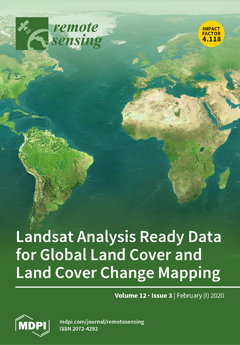Column-averaged dry air mole fraction of atmospheric CO
2 (XCO
2), obtained by multiple satellite observations since 2003 such as ENVISAT/SCIAMACHY, GOSAT, and OCO-2 satellite, is valuable for understanding the spatio-temporal variations of atmospheric CO
2 concentrations which are related to carbon
[...] Read more.
Column-averaged dry air mole fraction of atmospheric CO
2 (XCO
2), obtained by multiple satellite observations since 2003 such as ENVISAT/SCIAMACHY, GOSAT, and OCO-2 satellite, is valuable for understanding the spatio-temporal variations of atmospheric CO
2 concentrations which are related to carbon uptake and emissions. In order to construct long-term spatio-temporal continuous XCO
2 from multiple satellites with different temporal and spatial periods of observations, we developed a precision-weighted spatio-temporal kriging method for integrating and mapping multi-satellite observed XCO
2. The approach integrated XCO
2 from different sensors considering differences in vertical sensitivity, overpass time, the field of view, repeat cycle and measurement precision. We produced globally mapped XCO
2 (GM-XCO
2) with spatial/temporal resolution of 1 × 1 degree every eight days from 2003 to 2016 with corresponding data precision and interpolation uncertainty in each grid. The predicted GM-XCO
2 precision improved in most grids compared with conventional spatio-temporal kriging results, especially during the satellites overlapping period (0.3–0.5 ppm). The method showed good reliability with R
2 of 0.97 from cross-validation. GM-XCO
2 showed good accuracy with a standard deviation of bias from total carbon column observing network (TCCON) measurements of 1.05 ppm. This method has potential applications for integrating and mapping XCO
2 or other similar datasets observed from multiple satellite sensors. The resulting GM-XCO
2 product may be also used in different carbon cycle research applications with different precision requirements.
Full article





